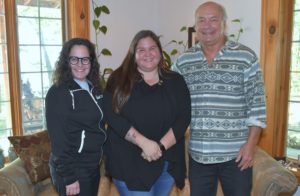University teaches shared stories of Nbisiing Aanishinaabeg

By Kelly Anne Smith
NIPISSING FIRST NATION – The class was held at Nbisiing Secondary School on Nipissing First Nation. Professor of History 1006 – Gaa Bi Kidwaad Maa Nbisiing – The Stories of Nbisiing Aanishinaabeg, Erin Dokis informed Nbisiing is more than reserve. It is honour, land, water and people.
Teaching alongside of her is John Sawyer, Elder-in-Residence at Nipissing University. Sawyer explains why the students are seated in a circle.
“Everyone is in the front row while we are building character.”
He says the use of a sharing stick will help everyone learn to listen.
Keynote speakers included Terry Dokis, Muriel Sawyer, June Commanda and Katrina Srigley over the course of two weeks. The intensive experiential course starts with an exploration of what and where history is in: art, songs, dancing, beading, petroglyphs, treaty belts, knowledge shared by Elders and through shared stories.
“Stories are held in nested circles,” explained Professor Erin Dokis. “Identity and belonging are across self, family, community and nation.”
John Sawyer occasional jokes to ease the seriousness of the many subjects he talks about because as he believes, sharing stories can become emotional.
“Keep that story telling going. There are hardships but there are also rewards. How that story leaves an impression makes the world a better place.”
Professor Dokis explains the first-year history class.
“One of the things we are trying to do is to teach the history of this land, this water, this territory and the people in a way that is truly Anishinaabe.”
The unique course is directed through Anishinaabe understandings of teaching and learning says Erin Dokis.
“We learn in circle. We tell stories. There is learning through less institutional kinds of ways like not placing people in rows with an expert at the front of the room. We are all the experts.”
Dokis motions a big circle to include all the participants.
“We bring in community members – knowledge keepers – to share their stories with the students. And so, the history and the stories come directly from the community…We do talk about different types of stories. We talk about sacred stories. We talk about origin stories. We talk about everyday stories as well that come out of the community. Those everyday stories are just as important.”
She adds the course is inclusive for non-Indigenous students as well.
“This education is really important for settler folks for potential allies certainly and for everyone to understand the history of the territory they are either from or that they are visiting.”
Recording history must be in ethical, responsible and respectful ways notes Dokis.
“Acknowledging this is the history of this territory, of these community members. It is not history to be taken… One of the things that we really focus on in the course is in order to learn history, it is important to understand your own and where you come from. History is always written and recorded and told from a particular perspective. And there are many perspectives. If you are going to learn about it, it’s important to have a sense of your own.”
Emily St. Germaine-Lewis feels the course helped her. She is a member of the Sturgeon Clan from Nipissing First Nation and Wiikwemkoong Unceded Territory.
“By nature of what is offered at the [Nipissing University], it is different than this. In classes, you are sitting in a lecture and you are taught in a very linear way. This class isn’t like that. Each day the conversation is based on what we wanted to say as a group. There was a central topic with each guest speaker. The course made me realize there are different approaches to learning and sharing knowledge.”
Majoring in Political Science and Native Studies, St. Germaine-Lewis wants to work with policy.
“I personally feel there is a disconnect between the way Indigenous people can exist within the current systems we have and whether I make a big or small impact on that. I want to be a part of the change that helps develop a healthier relationship or changes the policy so it better supports Indigenous People rather than stunting development.”
St. Germaine-Lewis’ father, Trevor Lewis, took the class as well.
“It’s been really exciting to take this kind of a class with him,” says St. Germaine-Lewis. “Nipissing is a very strong community. We have family connections with a lot of the speakers that came in, so it was really cool to learn things about my own family with him and the impacts people made… This course has taught me and demonstrated that we need to make spaces for Indigenous knowledge within the systems that currently exist. That creates the change.”


